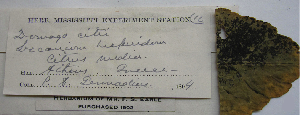
Polychaeton citri represents the Capnodiaceae (Capnodiales, Dothideomycetes) that are commonly referred to as sooty molds. These fungi are associated with excess honeydew excreted by sucking insects or plant exudates during warm weather periods and are deemed non-pathogenic. In particular, Polychaeton citri forms a black, powdery coating on the foliage and fruits of Citrus trees infested by scale insects and aphids. The growth of the black mycelium on plant surfaces is superficial and it can be removed completely. It only becomes an annoyance when abundant, because it reduces the rate of photosynthesis and causes allergies in some people. Capnodium citri is the teleomorphic (sexual) stage of Polychaeton citri. In the asexual stage, the fungus produces typical conidiospores that are hyaline and non-septate.
Genome Reference(s)
Haridas S, Albert R, Binder M, Bloem J, LaButti K, Salamov A, Andreopoulos B, Baker SE, Barry K, Bills G, Bluhm BH, Cannon C, Castanera R, Culley DE, Daum C, Ezra D, González JB, Henrissat B, Kuo A, Liang C, Lipzen A, Lutzoni F, Magnuson J, Mondo SJ, Nolan M, Ohm RA, Pangilinan J, Park HJ, Ramírez L, Alfaro M, Sun H, Tritt A, Yoshinaga Y, Zwiers LH, Turgeon BG, Goodwin SB, Spatafora JW, Crous PW, Grigoriev IV
101 Dothideomycetes genomes: A test case for predicting lifestyles and emergence of pathogens.
Stud Mycol. 2020 Jun;96():141-153. doi: 10.1016/j.simyco.2020.01.003
